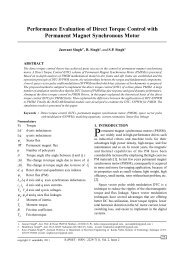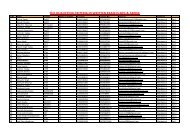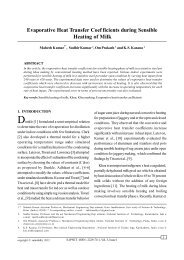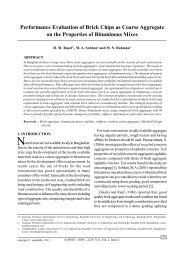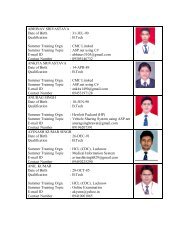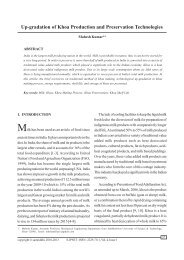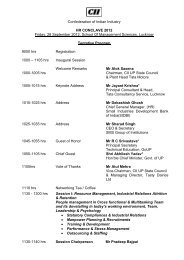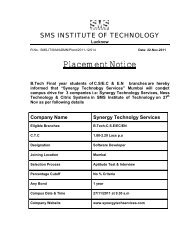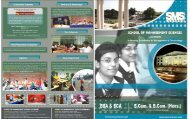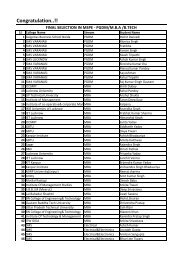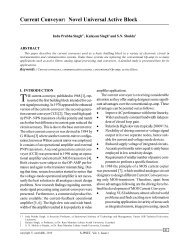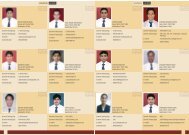Electronics Spectra - SMS Lucknow
Electronics Spectra - SMS Lucknow
Electronics Spectra - SMS Lucknow
You also want an ePaper? Increase the reach of your titles
YUMPU automatically turns print PDFs into web optimized ePapers that Google loves.
<strong>SMS</strong> Institute of Technology, L ucknow<br />
Department of <strong>Electronics</strong> & Co mmunication<br />
energy of a plasmon is analysis of the<br />
light spectrum emitted by plasmons.<br />
APPLICATIONS<br />
Plasmon waveguides, extraordinary<br />
transmission through aper ture<br />
arrays, sensing and surface enhanced<br />
Raman scattering, spectroscopy as<br />
well as meta-materials.<br />
Position and intensity of plasmon<br />
absorption and emission peaks are affected<br />
by molecular adsorption, which<br />
can be used in molecular sensors<br />
Potential applications extend to<br />
new light sources, solar cells, holography,<br />
raman spectroscopy, and microscopy<br />
applications of surface plasmon<br />
resonance spectroscopy was the measurement<br />
of the thickness of adsorbed<br />
self-assembled nanofilms on gold substrates.<br />
Most practical applications is SPR<br />
emission When the surface plas mon<br />
wave hits a local particle or irregularity-like<br />
on a rough surface<br />
GENERATION OF<br />
PLASMON<br />
Plasmons are generated when,<br />
under the right conditions, light strikes<br />
a metal. The electric field of the light<br />
jiggles the electrons in the m etal to<br />
the light's frequency, setting off density<br />
waves of electrons. The process<br />
is analogous to how the vibrations of<br />
the larynx jiggle molecules in the air<br />
into density waves experienced as<br />
sound.<br />
Metals provide the best evidence<br />
of plasmons, because they have a<br />
high density of electrons free to move.<br />
Plasmons are density waves of<br />
electrons, which are created w hen<br />
light hits the surface of a metal under<br />
precise circumstances. Because these<br />
density waves are generated at optical<br />
frequencies, very small and rapid<br />
waves. <br />
Hybrid computer<br />
Computers are devices that exhibit<br />
features of analog computers and digital<br />
computers. The digital component<br />
normally serves as the controller and<br />
provides logical operations, while the<br />
analog component<br />
normally<br />
serves as a<br />
solver of differential<br />
equations.<br />
In hybrid<br />
computer Signals<br />
pass across<br />
the synapses<br />
from one nerve<br />
cell to the next<br />
as discrete<br />
(digital) packets<br />
of chemicals,<br />
which are then<br />
summed within<br />
the nerve cell in<br />
an analog fashion<br />
by building<br />
an electrochemical<br />
potential<br />
until its threshold is re ached,<br />
whereupon it discharges and se nds<br />
out a series of digital packets to the<br />
next nerve cell. The advantage s are<br />
at least threefold: noise within the system<br />
is minimized (and tends no t to<br />
be additive), no common ground ing<br />
system is required, and there is minimal<br />
degradation of the signal even if<br />
there are substantial differen ces in<br />
activity of the cells along a path (only<br />
the signal delays tend to vary ). The<br />
individual nerve cells are analogous to<br />
analog computers; the synapses are<br />
analogous to digital computers.<br />
Note that hybrid computers should<br />
be distinguished from hybrid systems.<br />
The latter may be no more than a<br />
digital computer equipped with an<br />
analog-to-digital converter at the input<br />
and/or a digital-to-analog converter<br />
at the output, to convert analog<br />
signals for ordinary digital signal<br />
processing, and conversely, e.g., for<br />
driving physical control systems, such<br />
as servomechanisms.<br />
<br />
Gaurav Mishra<br />
EC - III year<br />
39 <strong>Electronics</strong> <strong>Spectra</strong>, 2010



